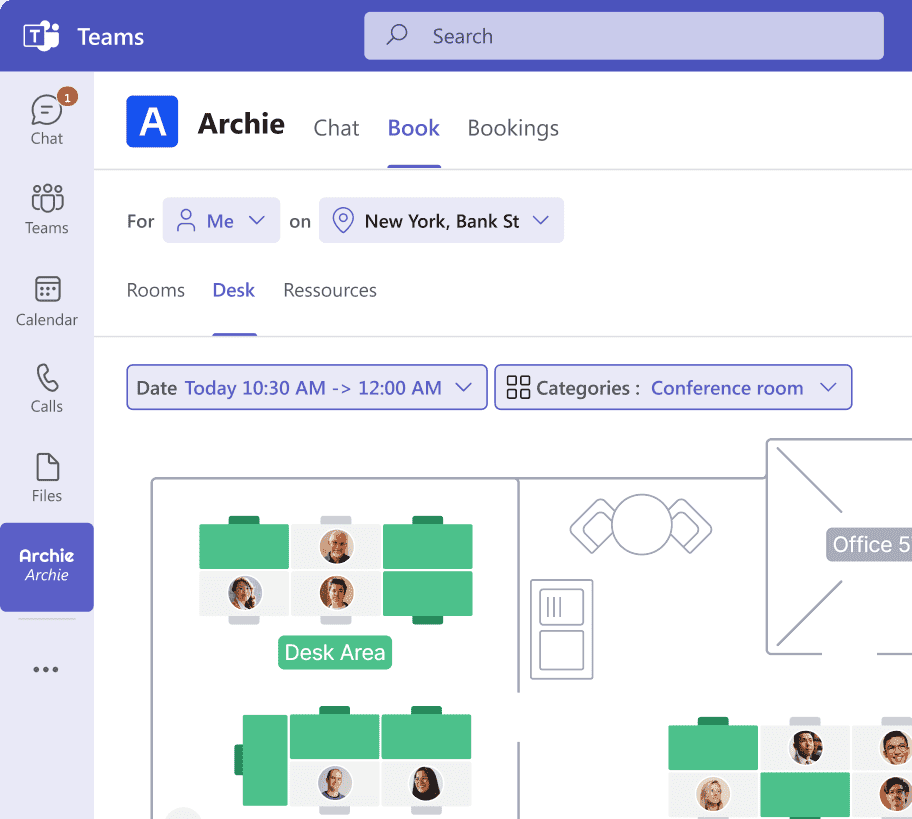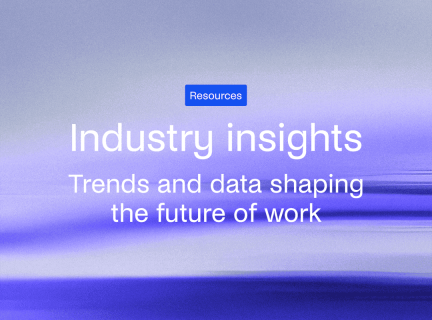Looking for a simple way to manage hot desk bookings?
Archie’s hot desk booking template in Excel is a budget-friendly option perfect for small teams (fewer than 10 people) working in the same office space.
The template is completely free to download.
What is an Excel desk booking tool?
An Excel desk booking tool is a simple way to manage desk reservations in an office using Microsoft Excel. It typically includes a desk booking spreadsheet where employees can see available desks and reserve them for a specific day or time. The tool might use tables, filters, or conditional formatting to show desk availability and track bookings. While it’s a basic and affordable option for small teams, it may lack the advanced features of dedicated desk booking software, such as automatic notifications, integrations, or real-time updates.
How to set up a desk booking system in Excel
Setting up an Excel desk booking tool is simple, but it can take time and effort to create it from scratch. That’s why we’ve made things easier with a ready-to-use, free desk booking template you can download and use immediately. Access the desk booking template for free.
Step 1: Specify your workspace layout
Once you download the desk booking spreadsheet, list all the desks in your office (numbered or named) in the first column. Use the top row to add dates for the booking period you want to cover. This will create a simple grid where each row represents a desk, and each column represents a day.
Step 2: Build the desk booking schedule
Within the grid, each cell will represent the booking status of a specific desk on a given day. Your team will use these cells to indicate whether a desk is booked, available, or pending. This clear layout makes it easy to check availability at a glance.
Step 3: Add dropdown menus for desk status
Use Excel desk booking tool’s data validation feature to create dropdown menus in each cell. These dropdowns should include options like “Available,” “Booked,” and “Pending.” This ensures users can only select valid options, reducing mistakes and keeping the system organized.
Step 4: Use color coding for clarity
Apply conditional formatting to automatically color-code the cells based on their status. For example, green indicates available, red indicates booked, and yellow indicates pending. This makes it easy to assess desk availability quickly and simplifies decision-making.
Step 5: Share the hot desk booking Excel template with your team
Once your Excel desk booking tool is set up, share it with your team. You can email the file or upload it to a shared platform like Google Drive or SharePoint. Make sure to set appropriate editing permissions so only authorized team members can make changes.
Step 6: Keep it updated
Assign someone to act as the system administrator. This person will be responsible for updating the desk booking spreadsheet, resolving scheduling conflicts, and ensuring the system stays accurate and up-to-date.
Using the hot desk booking template in Google Sheets
Google Sheets is a great alternative to an Excel desk booking tool, especially for teams that need easy access and real-time collaboration. Moving your desk booking system Excel template to Google Sheets allows your team to work together seamlessly, from anywhere, on any device with an internet connection.
Import and share with ease
You can quickly upload your hot desk booking system from Excel into Google Sheets without losing important formatting or dropdown menus. Once it’s uploaded, you can share the file with your team across departments or locations. Everyone with access can view and update the sheet at the same time, making it easier to coordinate bookings.
Real-time collaboration
Unlike the Excel desk booking tool, where updates need to be manually saved and shared, Google Sheets automatically saves every change as it happens. Everyone always has the latest version, reducing errors or outdated information. Team members can book desks simultaneously without worrying about conflicts or overwriting someone else’s work. Google Sheets webhook integrations can also trigger automated alerts when bookings are made.
Free hot desk booking system Excel limitations
While setting up a manual hot desk booking system in Excel or Google Sheets is relatively easy, it has some major limitations:
- Scalability challenges: As your team or coworking space gets bigger, managing bookings manually can become overwhelming. Tracking a growing number of reservations in a manual system is time-consuming and prone to mistakes.
- Higher risk of conflicts: The more people using the system, the greater the chances of double bookings or scheduling mix-ups. These issues can cause disruptions and make it harder to use desk space efficiently.
- No real-time updates: If the booking sheet isn’t updated instantly or team members forget to refresh their browser or file, it often results in confusion and frustration when people arrive to find their reserved desks unavailable.
Should you use a hot desk booking template?
A hot desk booking template is a great option for small teams or businesses that need a simple way to manage shared desks. If your office has just a few desks and team members don’t book them often, using a spreadsheet in Excel or Google Sheets can work well. It’s free, easy to set up, and lets employees check desk availability and reserve a spot without needing any complicated software.
Excel desk booking template is also useful for startups, freelancers, or coworking spaces where people don’t have assigned desks but need a basic system to avoid double bookings. However, if your office has many employees, frequent desk reservations, or follows a hybrid work model, a desk booking software might be a better choice. Software can help automate bookings, show real-time availability, and keep everything organized without the risk of errors.
Before deciding, think about what your team truly needs. If bookings are simple and occasional, a template will do the job. But if things start to get messy, desk booking software can save time and make the process smoother for everyone.
Which desk booking system is right for me?
When managing desks in a hybrid workplace or a coworking space, there are three main options: using a hot desk booking system in Excel or Google Sheets, building your own desk booking system, or investing in third-party desk booking software.
1. Hot desk booking Excel template
We’ve already mentioned that using Excel or Google Sheets is the simplest and cheapest option, especially for smaller teams that work in the same office and don’t need to book meeting rooms. If that’s the case, go ahead and try out our free hot desk booking template.
At the same time, filling out rows and columns can get tedious fast, especially for larger offices and teams. Mistakes like double bookings and mix-ups can easily happen since there are no real-time updates on availability.
Pros:
- Familiar and easy to use.
- Accessible anytime, with no need to learn new software.
- Perfect for small, simple setups.
Cons:
- Someone must oversee and maintain the desk booking spreadsheet, answer questions, and fix any issues.
- Tracking hot desking policies or hybrid schedules can become a mess.
- No real-time updates or reliable data for KPIs like productivity or collaboration.
- Can’t handle complex setups like booking rooms, desks, and focus areas in one place.
Managing desks shouldn’t be so tiring. Desk booking software takes the stress out of the process and changes how your business handles collaborative spaces. Unlike clunky desk booking spreadsheets, these tools make room reservations quick and easy, cutting down on admin work and freeing up time.
2. Building your own desk booking system
Creating custom desk booking software is the most tailored solution, but it’s also the most expensive and complex. While it gives you full control to design a system that meets your exact needs, the costs and effort involved can add up quickly.
Pros:
- Fully customized to your business requirements.
- Managed by your in-house team, so issues can be resolved quickly.
Cons:
- Expensive to develop, host, and maintain.
- Requires hiring developers or dedicating existing resources.
- Time-consuming to build, test, and add new features.
If you’re considering this route, be sure to weigh the long-term costs and effort required.
3. Third-party desk booking software
Dedicated desk booking systems help you reserve and manage desks easily, either in advance or on the spot, optimizing office space use. These systems are designed to streamline desk and resource management in hybrid workplaces and coworking spaces. They prevent double bookings with instant updates and sync with calendars to keep schedules organized, which makes it perfect for growing teams.
Pros:
- Advanced features include live availability, workplace analytics, floor plans, and desk booking filters.
- Grows with your team and office needs.
- Connects with tools like Google Workspace, Microsoft 365, and Slack.
Cons:
- More expensive than basic desk booking solutions like Excel.
- Initial configuration and training may take time.
Why replace your Excel booking system with a desk booking app
If you have a small team and just need something simple, an Excel hot desk booking template can do the job. If your needs are more complex and you’ve got the budget, custom-built software gives you more control. But if you’re looking for something that’s easy to use, works well with other tools, and can grow with your team, a third-party desk booking solution is usually the best choice.
Compared to an Excel desk booking tool, desk booking software like Archie offers:
- Flexible scheduling options: Desk booking can be done via a web app, mobile app, Google or Outlook calendars, Microsoft Teams, and Slack. Who needs desk booking spreadsheets if you have so many options to choose from?
- Recurring desk bookings: Users can reserve the same desks for regular office days, eliminating the need to book a desk daily.
- Interactive floor plans: Visual maps make selecting desks and viewing the office layout easy.
- Real-time availability: Desk booking systems provide live updates on desk availability to avoid double bookings or confusion.
- Finding coworkers easily: Features like employee lookup allow users to book desks near their teammates or business partners for easier collaboration. Some systems even send alerts when colleagues are in the office.
- Useful data insights: Desk booking tools track usage trends, peak times, and desk occupancy, helping office managers plan better and make the most of workspace resources.
- Smooth integrations: The best desk booking software connects with tools already in use, like calendars and communication apps, making it easier for teams to manage reservations seamlessly.
This means no more scrambling in the morning to grab a favorite desk or settling for a less-than-ideal spot. People can just walk into the office (or reserve a desk in advance), open the app, and pick a desired place to work. If you’re looking for a more efficient way to manage desks, this is a better solution than the hot desk booking template in Excel.
What to consider before choosing the right desk booking system
Here are a few important questions to ask yourself before choosing a desk booking system (be it in Excel, Google Sheets, or as a dedicated solution):
👩🏼💼 How many desks and employees?
If your office is small, with fewer than 10 people, an Excel desk booking template might be enough to keep track of desk reservations. But if you have a bigger team, managing everything manually can get tricky. A desk booking system makes it easier to organize desk usage and ensures everyone knows which spaces are available.
💻 Does it support hybrid work?
If some employees work from home on certain days while others come into the office, your system should support flexible workspace scheduling. Some team members may need a dedicated desk, while others can share workspaces. A good booking system should make it easy for everyone to find a spot that suits their work style.
📊 Can it track office usage?
A good desk booking system doesn’t just help people reserve desks — it also tracks office space usage. This means you can see how often desks are being used, how much space is needed, and how well employees are collaborating. These insights can help you improve how your office is set up.
If you have a small team and a simple setup, a hot desk booking template might work just fine. But if you’re looking for something that saves time, avoids scheduling mix-ups, and grows with your team, a desk booking system is the way to go. Think about how your team works now and what your office might need in the future before making your choice.

Berenika Teter
Archie's Content Manager, fueled by filter coffee and a love for remote work. When she’s not writing about coworking spaces and hybrid workplaces, you can probably find her exploring one.

















![Free Hot Desk Booking Template: Excel & Google Sheets [2026] A modern office space with people working behind hot desks.](https://archieapp.co/blog/wp-content/uploads/2024/12/Desk-booking-template-cover-image.jpg)





